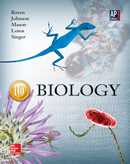1 Geospiza fortis maintained in the population on Daphne Major?A) Genetic drift. B) Beak size varies randomly. C) Selection pressures vary every few years depending on rainfall. D) Migration of birds among islands. E) A combination of all these factors. 2 A) No, it would not have increased at all. B) Yes, but it would have taken much longer. C) Yes, but it would have taken just slightly longer. D) Yes, but only in small and isolated populations. E) It's impossible to tell. 3 A) It is not. B) There are larger differences between breeds (e.g dogs) than there are between related species. C) It shows that selection can act very quickly on a geological time scale. D) Both 2 and 3 E) None of the above. 4 Archaeopteryx , which is considered to be an intermediate between dinosaurs and birds, not intermediate for all characters?A) Because Archaeopteryx is not a true intermediate. B) Different characters evolve at different rates at different times. C) Because it is a hybrid between a bird and a dinosaur. D) Because evolution does not create true intermediates. E) Because we lack the ability to differentiate homologous from analogous structures in fossils. 5 A) True B) False 6 A) A and B are similar to each other; C and are D different from each other. B) C and are D similar to each other; A and B are different from each other. C) A and are B different each other; C and D are similar to each other. D) A and B are similar to each other; C and D more similar to each other E) None of the above. 7 A) changes in global climates which resulted in changing environments from forest to grasslands. B) changes in global climates which resulted in changing environments from grasslands to forests. C) changing climates from dry to wet. D) changing climates from wet to dry. E) increase in reproduction of larger animals due to lack of water in the dry environment. 8 A) There is variation among individuals. B) Beak characteristics are inherited. C) Fitness differences among individuals are based on beak characteristics. D) 1 and 2 E) All of the above. 9 A) industrial pollutants turned the moths black. B) the selection pressure on the melanic and the non-melanic forms has reversed. C) of coincidence. D) of genetic drift. E) of assortative mating. 10 Drosophila ) greater than their original limits?A) It cannot. B) Mutation and recombination introduce new variation into these organisms. C) Artificial selection is stronger than natural selection. D) Artificial selection introduces new mutations. E) None of the above. 11 A) True B) False 12 A) homozygous. B) analogous. C) homophobic. D) homologous. E) hydrophobic. 13 A) pure chance. B) similar selection pressures. C) mutation. D) artificial selection. E) All of the above. 14 A) lanugo B) teosinte C) fossils D) radioactive isotopes E) vestigial structures 15 A) Biston betularia B) Geospiza fortis C) Archaeopteryx D) Hyracotherium E) Drosophila melanogaster





